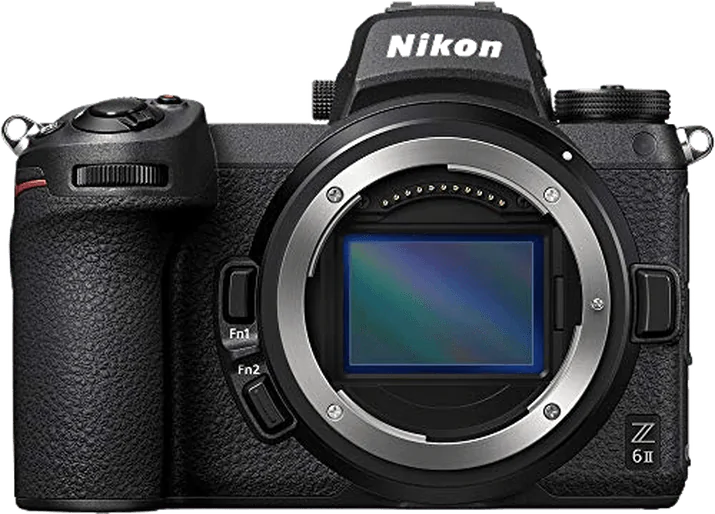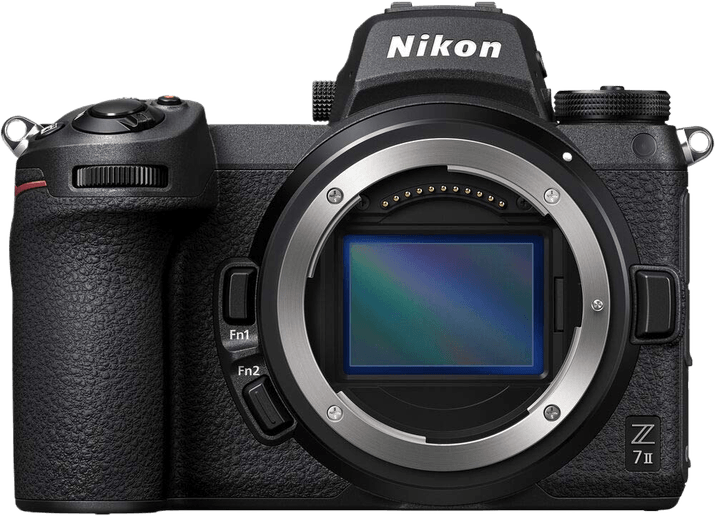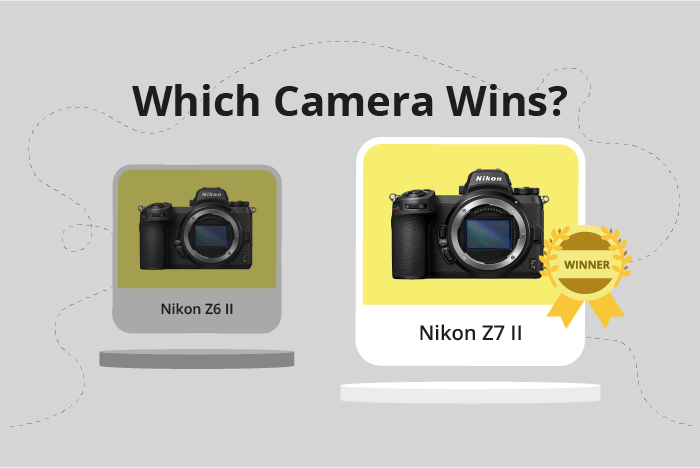Nikon Z6 II vs Z7 II Comparison
Nikon Z6 II

Nikon Z7 II

The Nikon Z7 II comes out ahead with a score of 85/100, while the Nikon Z6 II trails closely behind with a score of 83/100. Both cameras share several common specifications, such as being mirrorless, having the same announcement and release dates in 2020, and identical dimensions (134 x 101 x 70mm) and weights (705g / 1.55lbs). Additionally, they both have the same launch prices, with the Z6 II at $1995 and the Z7 II at $3399.
The Nikon Z7 II earns its higher score due to superior features, giving it an edge over the Z6 II. On the other hand, the Z6 II has its own advantages, such as a more affordable price, making it an attractive option for budget-conscious photographers.
In the end, the choice between the Nikon Z6 II and Z7 II comes down to individual preferences and budget. The Z7 II is the superior camera in terms of features and performance, while the Z6 II offers a more budget-friendly option without compromising too much on quality.
Nikon Z6 II vs Z7 II Overview and Optics
The Nikon Z7 II wins in the optics comparison with a score of 86/100, while the Nikon Z6 II scores 83/100. Both cameras share several specifications, such as the CMOS sensor type, Dual Expeed 6 processor, full-frame sensor size, Nikon Z lens mount, and image stabilization. These common features make both cameras strong contenders in the optics department.
The Z7 II outperforms the Z6 II primarily due to its higher megapixel count of 45.75 and a superior DXOMARK sensor score of 100. The increased megapixels provide greater image resolution and detail, while the higher sensor score indicates better overall image quality. These advantages make the Z7 II a better choice for photographers who prioritize image quality and detail, such as landscape and portrait photographers.
On the other hand, the Z6 II has a faster shooting speed of 14 frames per second, compared to the Z7 II’s 10 frames per second. This gives the Z6 II an edge in capturing fast-moving subjects or action photography, where a higher shooting speed is essential. However, this advantage does not outweigh the superior image quality offered by the Z7 II.
Considering the differences and similarities between the two cameras, the Nikon Z7 II emerges as the winner in the optics comparison due to its higher image quality and resolution. The Nikon Z6 II, while having a faster shooting speed, falls short in delivering the same level of image detail. Therefore, the Z7 II is the better choice for photographers who prioritize image quality and detail, while the Z6 II may be more suitable for those who require a faster shooting speed for action photography.
Nikon Z6 II vs Z7 II Video Performance
The Nikon Z6 II and Nikon Z7 II both have equal video capabilities, with a video score of 91/100. These cameras share several video features, making them strong contenders in the field of video capture.
Both the Nikon Z6 II and Z7 II offer 4K video resolution with maximum video dimensions of 3840 x 2160. They also have a maximum video frame rate of 120fps, which is ideal for capturing smooth, high-quality footage. Additionally, both cameras possess built-in time-lapse functionality, allowing users to create stunning time-lapse videos with ease.
However, there are no clear advantages for either camera in terms of video capabilities. The Nikon Z6 II and Z7 II share the same video specifications, resulting in a tie for this comparison. Users can expect similar performance from both cameras when shooting video, and the choice between them ultimately comes down to other factors such as price, design, and other features.
Though the video capabilities of the Nikon Z6 II and Z7 II are evenly matched, it is essential to consider the specific needs and preferences of the user. Some individuals may prioritize other aspects, such as image quality or autofocus performance, over video capabilities. In this case, the choice between the two cameras may become clearer. However, for those focused on video capture, the Nikon Z6 II and Z7 II offer equally impressive performance and features.
Nikon Z6 II vs Z7 II Features and Benefits
The Nikon Z6 II and Nikon Z7 II both score 87/100 in features, making them equal in this aspect. They share several specifications, including a 3.2-inch screen size, 2,100,000-dot screen resolution, touchscreen capability, GPS absence, and built-in Wi-Fi and Bluetooth connectivity.
The Nikon Z7 II has an advantage over the Z6 II with its flip screen feature. This allows for more versatile shooting angles and better composition, especially in challenging situations. The flip screen is valuable for vloggers and photographers who require flexibility in framing their shots.
On the other hand, the Nikon Z6 II does not have any distinct advantages over the Z7 II in terms of features. Both cameras have the same set of core specifications, making them equally capable in various shooting scenarios.
Given these points, the Nikon Z7 II is better for users who value the flip screen feature, while the Nikon Z6 II is equally capable but without the added benefit of a flip screen. Ultimately, the choice between these two cameras comes down to personal preference and the importance of the flip screen in one’s photography or videography needs. Both cameras excel in their shared specifications and offer a solid foundation for capturing high-quality images and videos.
Nikon Z6 II vs Z7 II Storage and Battery
The Nikon Z6 II and Nikon Z7 II both score 71/100 in storage and battery, indicating no clear winner in this category. Both cameras share identical features in this aspect, such as two memory card slots, compatibility with SD, CFexpress Type B / XQD (UHS-II) memory cards, EN-EL15c battery type, and USB charging support.
However, the Nikon Z7 II has a slight advantage in battery life, providing 420 shots compared to the Nikon Z6 II’s 410 shots. This minor difference may appeal to photographers who require extended shooting sessions without frequently changing batteries.
On the other hand, the Nikon Z6 II does not offer any unique benefits in storage and battery compared to the Z7 II. Both cameras perform similarly in this area, with the Z7 II having a marginal edge in battery life. This small distinction may not significantly impact the overall user experience, and potential buyers should weigh other factors when choosing between these two cameras.
Alternatives to the Nikon Z6 II and Z7 II
Are you still undecided about which camera is right for you? Have a look at these popular comparisons that feature the Nikon Z6 II or the Nikon Z7 II:

